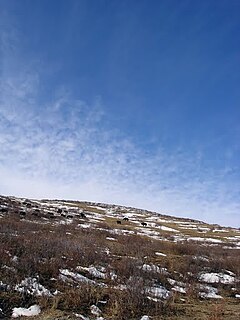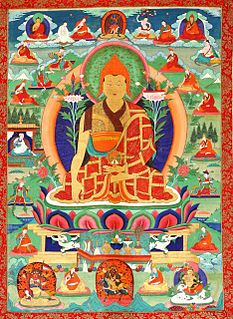Related Research Articles
Tibetan Buddhism is the form of Buddhism practiced in Tibet where it is the dominant religion. It is also found in the regions surrounding the Himalayas, much of Chinese Central Asia, the Southern Siberian regions such as Tuva, as well as Mongolia.

The Sakya school is one of four major schools of Tibetan Buddhism, the others being the Nyingma, Kagyu, and Gelug. It is one of the Red Hat Orders along with the Nyingma and Kagyu.
The Kālachakra is a term used in Vajrayana Buddhism that means "wheel(s) of time".
The Jonang is one of the schools of Tibetan Buddhism. Its origins in Tibet can be traced to early 12th century master Yumo Mikyo Dorje, but became much wider known with the help of Dolpopa Sherab Gyaltsen, a monk originally trained in the Sakya school. The Jonang school was widely thought to have become extinct in the late 17th century at the hands of the 5th Dalai Lama, who forcibly annexed the Jonang gompas to his Gelug school, declaring them heretical.

Ngawang Lobsang Gyatso was the 5th Dalai Lama and the first Dalai Lama to wield effective temporal and spiritual power over all Tibet. He is often referred to simply as the Great Fifth, being a key religious and temporal leader of Tibetan Buddhism and Tibet. Gyatso is credited with unifying all Tibet after a Mongol military intervention which ended a protracted era of civil wars. As an independent head of state, he established diplomatic relations with China and other regional countries and also met early European explorers. Gyatso also wrote 24 volumes' worth of scholarly and religious works on a wide range of subjects.

Dölpopa Shérap Gyeltsen (1292–1361), known simply as Dölpopa, was a Tibetan Buddhist master. Known as "The Buddha from Dölpo," a region in modern Nepal, he was the principal exponent of the shentong teachings, and an influential member of the Jonang tradition of Tibetan Buddhism.

The Palcho Monastery or Pelkor Chode Monastery or Shekar Gyantse is the main monastery in the Nyangchu river valley in Gyantse, Gyantse County, Shigatse Prefecture, Tibet Autonomous Region, China. The monastery precinct is a complex of structures which, apart from the Tsuklakhang Monastery, also includes its Kumbum, believed to be the largest such structure in Tibet, that is most notable for its 108 chapels in its several floors and the old Dzong or fort.

GologTibetan Autonomous Prefecture is an autonomous prefecture occupying the southeastern corner of Qinghai province, People's Republic of China. The prefecture has an area of 76,312 km2 (29,464 sq mi) and its seat is located in Maqên County.

Tāranātha (1575–1634) was a Lama of the Jonang school of Tibetan Buddhism. He is widely considered its most remarkable scholar and exponent.
Orgyen Kusum Lingpa (1934-2009) was a Tibetan terton and Nyingma lineage holder within Tibetan Buddhism. His name means "Holder of the Sanctuary of the Trikaya of Oddiyana Padmasambhava."
Katok Tsewang Norbu' was a teacher of the Nyingma school of Tibetan Buddhism) who notably championed the shentong or "empty of other" view first popularised by the Jonang school as well as examining the Chan Buddhist teachings of Hashang Mahayana, known as Moheyan. Despite the shentong view being banned as heretical, he successfully taught and cultivated its teachings as a legitimate view among the Nyingmapa.
Ocean of Definitive Meaning: A Teaching for the Mountain Hermit, written in the first half of the 14th century, is considered the magnum opus of Dolpopa Sherab Gyaltsen (1292–1361). The Ocean of Definitive Meaning is a hermeneutical text on the issue of the doctrine of the Three Turnings of the Wheel of Dharma that was first codified in the Sandhinirmocana Sutra.
Jianmoda Monastery is a Tibetan Buddhist monastery of the Jonang sect in the Golog Tibetan Autonomous Prefecture of Qinghai province, China. It is located on the slope of the Yamrixumo Mountain in the Jianmo River Valley, in Sogrima Township, 87 km west of Chorzhi County's Zhiqensomdor Township. The Zamda River is located to the left of the monastery and the Jianmo River is located in front.
Langboin Monastery or Dor'oxoizhuling is a Tibetan Buddhist monastery of the Jonang sect in the Golog Tibetan Autonomous Prefecture of Qinghai province, China. It is located 10 km west of Baima County in Langboin village, in Moba Township.
Nyingyor Monastery is a Tibetan Buddhist monastery of the Jonang and Gelug sect in the Golog Tibetan Autonomous Prefecture of Qinghai province, China. It is located in Nyingyor on the eastern bank of Shake River in Kangse Township, seven km south of Chorzhi County's Zhiqensomdor Township.

Banma County is a county of Qinghai Province, China. It is under the administration of Golog Tibetan Autonomous Prefecture. The Red Army of the Chinese Communist Party passed through Banma in 1936 during the Long March. The seat of Baima county is in Sailaitang Town (赛来塘镇).

Jigme Gyatso is a Tibetan filmmaker and human rights activist. After assisting with the documentary Leaving Fear Behind, he was arrested by Chinese authorities on at least three occasions. He alleges that he was tortured following his March 2008 arrest.

The Ganden Phodrang or Ganden Podrang was the Tibetan government that was established by the 5th Dalai Lama with the help of the Güshi Khan of the Khoshut in 1642. Lhasa became the capital of Tibet in the beginning of this period, with all temporal power being conferred to the 5th Dalai Lama by Güshi Khan in Shigatse. After the expulsion of the Dzungars, Tibet was under administrative rule of the Qing dynasty between 1720 and 1912, but the Ganden Phodrang government lasted until the 1950s, when Tibet was incorporated into the People's Republic of China. Kashag became the governing council of the Ganden Phodrang regime during the early Qing rule.
Rangtong and shentong are two distinctive views on emptiness (sunyata) and the two truths doctrine within Tibetan Buddhism.

Although there were many householder-yogis in Tibet, monasticism was the foundation of Buddhism in Tibet. There were over 6,000 monasteries in Tibet. However, nearly all of these were ransacked and destroyed by Red Guards during the Cultural Revolution. Most of the major monasteries have been at least partially re-established, while many others remain in ruins.
References
- ↑ Monasteries of the Jonang Sect in Golog Archived July 19, 2011, at the Wayback Machine , Tibetinfor.com
| This article about a Buddhist convent is a stub. You can help Wikipedia by expanding it. |